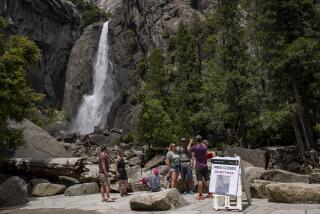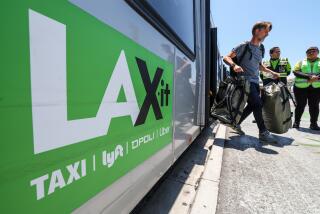Cars May Take Backseat to Shuttles at Yellowstone
- Share via
BILLINGS, Mont. — Yellowstone National Park is preparing to test the public’s appetite for mass transit, hoping that visitors will consider giving up their minivans and road-clogging recreation vehicles for commuter buses.
“This park is just being loved to death,” said Jim Evanoff, a management assistant at Yellowstone. “We’re starting to send the signal that private cars are not necessarily going to be the future at Yellowstone.”
The mass transit idea, still in its infancy, is part of a program intended to reduce air and noise pollution and improve the overall environment within the country’s first national park.
Yellowstone recently purchased a small fleet of the famous old yellow tour buses that were phased out of service in the park in the 1950s. Once a chief source of visitor transportation, the buses will be refurbished and are expected to return to service in a few years, Evanoff said.
The buses likely would be used at first for shuttle service between some of the park’s more popular sites, which are often clogged with vehicles and slowed by traffic jams.
Evanoff and others, however, hope that the buses will be just one component of a greater transportation system that will dramatically cut the number of private vehicles touring the park.
“I envision mass transportation, such as bus companies, bringing people to entrance gates and people hopping onto some sort of transportation system ... where you have control of the visitor and minimal disturbance of wildlife,” Evanoff said.
In many national parks, mass transit is an accepted means of travel for visitors. It is also becoming an option for park managers seeking solutions to traffic jams and ways to handle a growing number of visitors.
Some environmentalists praise the option as progressive and plain smart planning.
“We’re adding several million people to our country’s population each year and we’re not making any more Yellowstones,” said Jon Catton, a spokesman for the Greater Yellowstone Coalition, a Bozeman, Mont., conservation group. “It follows that we’re going to need new ways for people to access and enjoy the national parks that belong to them without overwhelming the very qualities that make the park special.”
Fun and nostalgia became key selling points this summer to increase bus tours in Glacier National Park in northwestern Montana. The park brought back some of its red 1930s touring buses that were taken off the road in 1999 for safety reasons. Refurbished and updated from the wheels up, the buses drew near-capacity loads and were credited for a 20% increase in the number of guided van tours in the park, said Rich Bond, transportation manager with Glacier Park Inc.
The buses, with convertible tops, use cleaner-burning propane and reduce park traffic, Bond said.
“One of the real problems parks have had is attracting people to get on tour vehicles because there is nothing unique about them,” he said. “Your guides could be as good as gold, but people want something different.”
The point is not lost on Yellowstone. It is a reason that officials are interested in the old tour buses for shuttles.
“Our concept would be to provide a kind of vehicle and experience that would entice people out of their vehicles to see the park in a different way,” said John Sacklin, the park’s chief of planning.
About 3 million people visit Yellowstone each year. If visitation increases, so does the number of private vehicles, leading to more congestion along popular routes.
Having even just a portion of visitors use shuttles instead of private vehicles could make a difference, Sacklin said.
At Rocky Mountain National Park in Colorado, officials first began offering shuttle service in 1978 to reduce congestion, parking problems and damage to park resources, Chief Ranger Joe Evans said.
Roughly 60 people can fit on today’s buses, which are handicap-accessible, air-conditioned and equipped with big windows. Routes join at a central parking area, he said, and about 264,000 people used the free service last year.
Sacklin said he didn’t know when shuttle buses would begin running in Yellowstone or how widespread the program might be.
“Looking at alternative modes of transportation in Yellowstone is really a very complex, long-term kind of question,” he said. However, “it behooves us now to explore possible solutions before the issue is really upon us in a big way.”
More to Read
Sign up for The Wild
We’ll help you find the best places to hike, bike and run, as well as the perfect silent spots for meditation and yoga.
You may occasionally receive promotional content from the Los Angeles Times.






